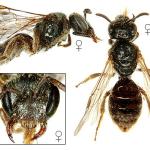Lasioglossum punctulata KIRBY, 1802
Widely distributed in England and Wales, and north to southern Scotland. Also found in Ireland, the Isles of Scilly and the Channel Islands. Abroad, the species is distributed across the Palaearctic region, from Europe to Mongolia and north to 64 degrees.
This species is not regarded as being scarce or threatened.
Found in many habitats, including coastal soft rock cliffs. In Wales and north- west England it is largely coastal.
Bivoltine. The females are to be found in flight from mid-March, although more commonly from early April, until October. Males appear in late June and fly until mid-October. There is a peak of activity in July and August, and very limited data for early November. Information on the sex of these late specimens is not available.
A solitary mining species, although nests may be found in aggregations. Occasionally, two females of the same generation share a nest entrance but these nests are thought to be communal rather than primitively eusocial. The main burrow is dug vertically, with lateral burrows off this leading to horizontal cells. A small tumulus accumulates at the nest entrance as digging is carried out. As soon as it is constructed, each cell is fully provisioned, an egg laid and the cell sealed off. This means the adult female bee has no contact with the larva.
Included are: alexanders (Smyrnium olusatrum), buttercups (Ranunculus spp.), creeping thistle (Cirsium arvense), hawthorn (Crataegus mongyna), hogweed (Heracleum sphondylium) and plum (Prunus sp.), as well as yellow Asteraceae (GHL Dicker, unpublished).
There are no Sphecodes species which are host specific on L. villosulum, but some of the more general Sphecodes may parasitise this bee.
2006


